心肌细胞荧光原位杂交技术。
IF 4.7
2区 医学
Q1 CARDIAC & CARDIOVASCULAR SYSTEMS
引用次数: 0
摘要
测量心肌细胞核倍体对于评估心脏发育、功能和疾病进展的更广泛方面至关重要。荧光原位杂交(FISH)仍然是鉴定倍性的金标准;然而,其在心肌细胞中的应用受到其独特的细胞复杂性的阻碍。在这里,我们描述了一个详细的心肌细胞特异性FISH (cardioFISH)方案。CardioFISH结合了量身定制的酶消化策略,以增强核可及性,同时保持细胞完整性并最大限度地减少肌瘤来源的自身荧光。此外,我们引入了一个用于全面cardioFISH信号分析的3D核可视化框架,解决了心肌细胞大核尺寸所带来的限制,其中信号经常分布在多个成像平面上。这项为期两天的cardioFISH方案适用于心肌细胞发育的各个阶段,并为推进心肌细胞倍体的研究提供了强大的工具。本文章由计算机程序翻译,如有差异,请以英文原文为准。

Fluorescence in situ hybridization protocol for cardiomyocytes
Measuring cardiomyocyte nuclear ploidy is crucial for evaluating broader aspects of cardiac development, function, and disease progression. Fluorescence in situ hybridization (FISH) remains the gold standard for ploidy identification; however, its application in cardiomyocytes is hindered by their unique cellular complexities. Here, we describe a detailed cardiomyocyte-specific FISH (cardioFISH) protocol. CardioFISH incorporates a tailored enzymatic digestion strategy to enhance nuclear accessibility while preserving cellular integrity and minimizing sarcomere-derived autofluorescence. Additionally, we introduce a 3D nuclear visualization framework for comprehensive cardioFISH signal analysis, addressing the limitations imposed by the large nuclear dimensions of cardiomyocytes, where signals are frequently distributed across multiple imaging planes. This two-day cardioFISH protocol is applicable to various stages of cardiomyocyte development and provides a powerful tool for advancing studies of cardiomyocyte ploidy.
求助全文
通过发布文献求助,成功后即可免费获取论文全文。
去求助
来源期刊
CiteScore
10.70
自引率
0.00%
发文量
171
审稿时长
42 days
期刊介绍:
The Journal of Molecular and Cellular Cardiology publishes work advancing knowledge of the mechanisms responsible for both normal and diseased cardiovascular function. To this end papers are published in all relevant areas. These include (but are not limited to): structural biology; genetics; proteomics; morphology; stem cells; molecular biology; metabolism; biophysics; bioengineering; computational modeling and systems analysis; electrophysiology; pharmacology and physiology. Papers are encouraged with both basic and translational approaches. The journal is directed not only to basic scientists but also to clinical cardiologists who wish to follow the rapidly advancing frontiers of basic knowledge of the heart and circulation.

 求助内容:
求助内容: 应助结果提醒方式:
应助结果提醒方式:


